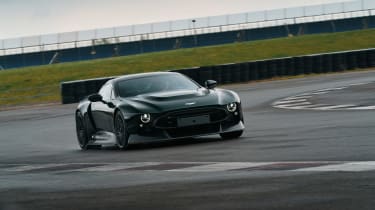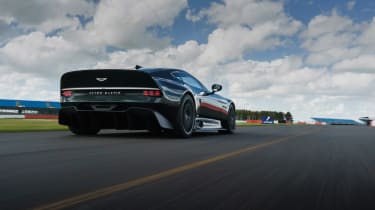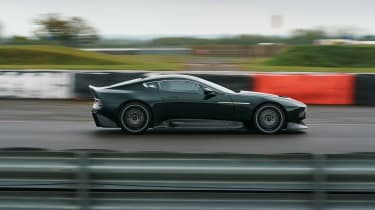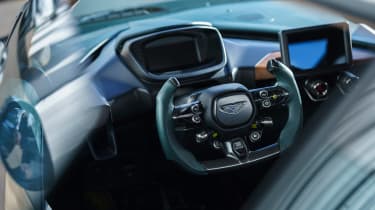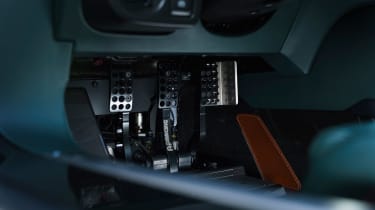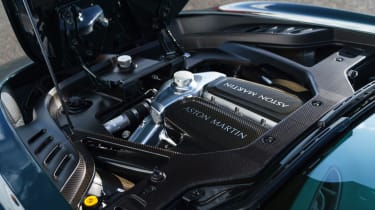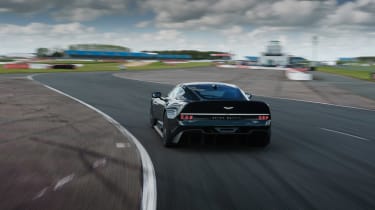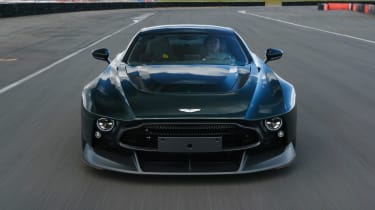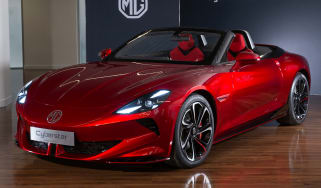Aston Martin Victor review – one-off V12 hypercar driven
The one-off Aston Martin Victor commission is as spectacular as we could have imagined
One-of-one. When it comes to collector cars, there’s no greater statement than a true one-off commission. And when it comes to true one-offs, few if any can compete with the sensational Aston Martin Victor.
A celebration of the Vantage nameplate’s 70th anniversary and styled to evoke the bruising Vantage flagships of the 1970s and ’80s, Victor is both a glorious throwback and a contemporary hypercar. Best of all, there’s quite literally nothing else like it.
We’ve grown used to Aston’s ability to create very special cars for very wealthy clients, but even projects such as the recent Vantage V600 (tested in evo 274) evolved from the vision of an individual into a very limited run – primarily to amortise the prodigious cost of designing, engineering, building and developing a unique car.
No such compromise for the owner of Victor, who was prepared to bear the full brunt of the cost in order for it to be a true unicorn. Quite how much they’ve spent remains confidential, but it wouldn’t surprise us if the number is somewhere near the £5million mark, or maybe even more. Like all money-no-object projects, it’s a mind-blowing sum, but as Ferris Bueller once said, ‘You can never go too far.’
Few marques have the appetite or in-house skillset to fulfil this type of commission, but not only were Aston’s design and Special Vehicle Operations departments very much up for the challenge, but past projects gave them an enviable parts bin to rummage in. Carbon chassis? Check! Mighty, naturally aspirated V12 engine? Check! Track-honed suspension and braking systems? Check-check! Consequently the Victor is a glorious mash-up of major One‑77 and Vulcan components, with a ton of bespoke work on top to create the exterior and interior.
More reviews
Group tests
- Aston Martin Vantage V600 v Aston Martin Vantage GT8 – limited-run Astons go head-to-head
- Aston Martin Vantage vs Audi R8 V10 RWD – back to basics
- BMW E30 M3 v E46 M3 CSL v F87 M2 CS
- BMW M8 Competition Gran Coupe vs Audi RS7 Sportback – battle of the alt-supersaloon
- Caterham Super Seven 600 v Super Seven 2000
- Levante v T1
- Corvette Stingray v Porsche Cayman GTS v Audi R8 RWD
- Hardcore Ferrari V8 specials go head-to-head
- Evolution of the Ferrari GT: 365 GTB4 Daytona to the 812 Superfast
- Lamborghini Aventador Ultimae v Lamborghini Countach
In-depth reviews
- Audi RS7 Sportback Performance review
- Bentley Continental R Mulliner: review, history and specs
- BMW M5 Touring (E61, 2007 - 2010): review, specs and buying guide
- BMW X7 review
- Cupra Leon review
- Genesis G70 review
- Ginetta G56 GTA review – a fabulous portal into the world of motorsport
Long term tests
- Alpina B10: end of term report
- Alpina B10
- Alpina B10
- Alpina B10
- Ford Mustang GT
- Ford Mustang GT
- Ford Mustang GT
- Mitsubishi Evo MR 340
- Mitsubishi Evo MR 340
- Mitsubishi Evo MR 340
Review
- New Aston Martin DBS 770 Ultimate review – 759bhp super-GT driven
- New Bentley Batur 2023 review – can it possibly be worth £1.65m?
- 2023 Chevrolet Corvette C8 Z06 review – the American 911 GT3?
- Kia EV6 GT-Line S prototype review – the EV that shows how it’s done
- BBR Supercharged Mazda MX-5 (ND) 2023 review – tuned 250bhp roadster driven
- MG4 Trophy 2023 review
Reviews
- Abarth 500e 2023 review
- AC Cobra 378 Superblower MkIV 2021 review – another V8 Cobra, but with a GM heart this time
- Alfa Romeo Tonale 2023 review – 276bhp Speciale version tested
- Alfa Romeo Giulia Veloce 2023 review
- Alfa Romeo Giulia GTAm 2021 review – if Porsche built a four-door 911 GT3 RS
- Alfa Romeo SZ: history, review and specs of an icon
- Alfa Romeo 1750 TBi
Of all Aston’s special-series cars, the One‑77 remains the greatest enigma. This is largely due to a policy of not letting the motoring media drive it, but also because it was a difficult car to pigeonhole thanks to the juxtaposition of its couture styling and rampant, Cosworth-developed V12. Not to mention the Automated Sequential Manual transmission that fell awkwardly between the purity and engagement of a traditional manual and the immediacy of the best paddleshift ’boxes. By contrast, the track-only Vulcan – which was itself an extreme evolution of the One‑77 – was better resolved for its intended purpose, more accessible to the media and more clearly understood by all of us as a result.
The Victor is built around a One‑77. That’s to say the carbonfibre Multimatic-built tub, the rear end, 7.3-litre engine and six-speed transmission. Starting life as a One‑77 means the Victor has the identity of a road-legal car – something the owner was insistent upon – and is already fitted with items such as E-marked glass, which would be ferociously costly and time-consuming to make and certify for a one-off car. Other smart adoptions of existing components include the use of Valkyrie tail-lights.
For Victor the One‑77’s V12 has benefited from extensive reworking by original builders Cosworth. Now developing 836bhp and 599lb ft – up from 750bhp and 553lb ft – the Victor is the most powerful naturally aspirated Aston Martin we’ve yet driven. Aston also retained the One‑77’s six-speed Graziano transmission but, instead of sticking with the ASM version, the gearbox has been ‘manualised’ by removing the automated paddleshift system.
Aston then got more creative with the inboard suspension and carbon braking systems developed for the Vulcan. Likewise, the Victor features Vulcan-style side-exit exhausts, rather than the rear-exit system fitted to the One‑77, to allow for a more extensive and effective rear diffuser. Together with the lantern-jawed front splitter this means the Victor’s upper body surfaces (which are all carbonfibre) can remain clean, in the spirit of those ’70s Vantages. The final flourish is the exaggerated and frankly wonderful upswept boot spoiler.
The interior is very special indeed, mixing the modern race car vibe of the Vulcan with the bespoke, crafted feel of an old-school Aston. As you’d expect, there’s lots of exposed carbonfibre, especially in the footwells, where the high-gloss tub is there for all to see and admire. There’s also acres of lovely supple leather wrapping the seats and ridiculously deep dashboard, which extends for what seems like a good metre ahead of you towards the base of the vast windscreen. However, the highlight for me is the solid ‘crown-cut’ walnut, which has a beautiful oiled finish and looks absolutely fantastic. Especially when used to form the round and wonderfully tactile gearknob.
The whole project reeks of the kind of design and engineering adventure few can hope to experience in their careers. That is unless you’re Amerpal Singh, not just lead vehicle engineer on Victor, but also on the V12 Speedster and DBS Zagato. Before working at Aston he was at Jaguar working on the Project 8. Special projects are his bread and butter, but even he’s somewhat smitten by Victor.
‘It’s pretty epic!’ he beams, before continuing in more engineer-y terms. ‘The Victor project had already been started when I joined AML from JLR, but only so far as refining the customer’s vision, which was for a more focused One‑77 with a manual transmission and a look that captured the ’70s Vantage. I came on board when the engineering began. Of course it’s a big challenge, but the beauty with these customer commissions is you’ve got that singular vision. We quickly established it would be based upon a One‑77 tub, engine and transmission [albeit evolved and adapted] but use the Vulcan suspension system and brakes. So it actually refines very quickly what the car should be, which means there’s nothing done by committee.’
Perhaps the only conformist aspect of the Victor is its name. The latest in Aston Martin’s long-established ‘V car’ naming protocol, the Victor moniker doesn’t pack the punch of Vantage, Vanquish or Vulcan. Especially if you’re old enough to remember the boxy ’70s Vauxhall saloon, or had a great uncle Victor. Better to make the link to the Cold War strategic bomber designed to drop A-bombs on the commies, or the former chairman of Aston Martin, the ebullient Victor Gauntlett.
Funnily enough, AML used a rather more evocative internal codename for the car during its development: Muncher. This was borrowed from a remarkable privateer Aston Martin, the RHAM 1, which was owned and run by Robin Hamilton. The original Muncher raced at Le Mans in 1977 (where it finished 17th overall and 3rd in class) and again in 1979, this time sporting an outlandish aerokit and a twin-turbocharged V8 boasting very similar power to the Victor.
This later iteration was a valiant failure, retiring after less than three hours due to engine woes, but both versions of the car attained cult status amongst race fans and Aston Martin enthusiasts. As for its nickname? Well, that was given to it by Hamilton and his team on account of its voracious appetite for brake discs! Different times for sure, but it’s rather wonderful that something of The Muncher’s maverick spirit lives on in another glorious one-off Aston project.
Unsurprisingly, it’s quite a moment when you finally get to drive the Victor. I’ve been fortunate to get behind the wheel of many extremely valuable cars over the years. There’s a certain responsibility, but I’ve always managed to calm myself by silently repeating ‘It’s just a car’ in my head. In Victor, my mental mantra is ‘the only one’. If there’s a car you don’t want to damage, it is this.
Like so many Astons before it, you enter the Victor having pulled on the flush-fit ‘lollypop’ door handle. The door itself swings light on its strut-assisted arc, leaving the wide sill (containing the exhaust pipe through which the left bank of the V12 exhales) to navigate before dropping down into the low seat.
Settle yourself into the Forest Green leather, press the Engine Start button on the steering wheel, and after a short, frantic spin of the starter motor the raucous V12 fires into life. The noise isn’t ear-splitting, but it has the immersive nature of the best surround-sound systems, deep bass notes mixed with the brittle timbre of a dozen pistons busily scurrying up and down within their bores. Unlike in the Vulcan there’s no clatter and chatter of a straight-cut racing transmission, nor the sharp hiss and crack of a pneumatic shifter. It’s noisier than mainstream exotics, but remains a very tolerable place to find yourself.
Weirdly my right fingers instinctively reach for a paddle with which to select first gear. Pretty dumb, I know, but it shows how we’re becoming conditioned not to expect a manual gearbox. Mildly embarrassed at my gaff, I depress the clutch (weighty, but not a calf-buster) and palm the lovely ball of machined walnut across the gate. The clutch is far easier than I’m expecting, at least so long as you resist the temptation to introduce too many revs and instead feed the clutch in with a minimum of fuss. It might be a dying art, but shifting gears manually will always be an integral part of the definitive driving experience, even the bit where you pray you won’t stall the car in front of a crowd.
The yoke-like steering ‘wheel’ is a fine piece of sculpture and feels great in your hands, initially at least: anything over half a turn of lock feels a bit awkward, if only because when you get to three-quarters of a turn you’re either reaching for the flat bottom, or pushing the wheel round using the tip of the yoke. Either way it focuses you on how little lock there is to play with, and confirms that if you’re exploring the outer reaches of the rack you’re either doing a three-point turn or in the middle of a spin.
Both steering and gearshift require a proper amount of effort, at least in the context of other 21st century hypercars. The steering weight is the bigger surprise, but the heft is welcome and entirely appropriate given the look and character of the Victor. You also need to apply significant pedal pressure on the carbon brakes (380mm front, 360mm rear), but the overall effort levels are nicely matched to the resulting response, so the effect is one of satisfying physicality.
As you’d hope, the engine is an absolute force of nature. There’s terrific throttle response and an ever-swelling sense of propulsion, with plenty of torque and a feral appetite for revs. Very few cars can match it for drama, with the process of wringing it out through the gears leaving your mouth dry and your palms moist. Aston hasn’t released any performance figures, nor an official kerb weight, but if you assume it sits somewhere between the 1350kg Vulcan and 1650kg One‑77 – let’s say 1500kg – then we’re talking somewhere in the region of 560bhp/ton, which is serious shove by any standards. We reckon it’d be good for 220mph and with a decent launch should crack 0-60mph in around 3sec, but it’s the almighty in-gear punch and satisfaction of nailing a clean upshift or heel-toeing down the ’box while heaving against the shoulder harnesses under heavy braking that’s the essence of the Victor driving experience.
The view from the driver’s seat is extraordinary and a little intimidating, for you sit so far back from the base of the screen that the front wheels could be in another county (a distinct possibility at Silverstone, which straddles Northamptonshire and Buckinghamshire), but you soon learn that the Victor can be placed neatly at the apex of any corner if you learn to look that little bit further ahead.
On Michelin Pilot Cup 2s there’s plenty of grip (at least when the track’s dry), which is supported by a multi-stage traction control system that can be adjusted via a neat rotary barrel switch on the right spoke of the steering wheel. It’s not stability control as you’d know from a road car, so respect is still due – especially on a damp or wet track – but the way it intervenes, even when relaxed to a very lenient setting, gives you plenty of warning the V12 is winning out against the rear tyres.
Even so, when powering along Stowe’s straights on wet tarmac (I was lucky to drive it on a couple of occasions) I’m mindful of every flair in revs, just in case the V12 gets away from the traction control and the Victor flicks sideways. It doesn’t, but that’s not to say it wouldn’t, and I’d much rather not be the one to find out.
With useful but far from Vulcan-esque levels of downforce, you get plenty of confidence that the Victor will scribe your chosen line. Out on the ultra-fast sweeps of Silverstone’s GP circuit this impression would doubtless increase, but within the tight confines of Stowe the Victor is relying more on its contact patches than its aerodynamics.
Encouragingly, it’s a car that actually feels alive and engaging at any speed. You also have a little bit of warning before the front begins to push wide or the tail starts to slip, so once you’ve tuned in to its behaviour the Victor is a car you are ahead of and can predict, rather than a car that’s always forcing you to react.
This bodes very well indeed for the Victor’s owner, should they stay true to their intention of driving it on the road. A non-circuit environment would certainly add another dimension to enjoying the Victor. With trees, road furniture and narrower stretches of tarmac, the impression of speed – already intense – will be magnified.
The focus and aggression Victor has inherited from the Vulcan will give it the thrill of a road racer, but there’s also a sense that it possesses some of the One‑77’s Super GT capabilities, so it’s a car you’d want to take on a proper trip. Oh, and switching from the sub-par ASM system to a satisfying manual-shift transmission is a stroke of genius. One I’d definitely investigate if I owned a One‑77.
We all have lottery-win fantasies. Victor is mine.
Specs
| Engine | V12, 7312cc |
| Power | 836bhp @ 7800rpm |
| Torque | 599lb ft @ 6500rpm |
| Weight | c1500kg (est) |
| Power-to-weight | c560bhp/ton (est) |
| 0-62mph | |
| Top speed | c220mph |
| Basic price | £5million (est) |
Our review of the Aston Martin Victor was first published in evo 286. To purchase any back issues or subscribe head over to our online shop here
